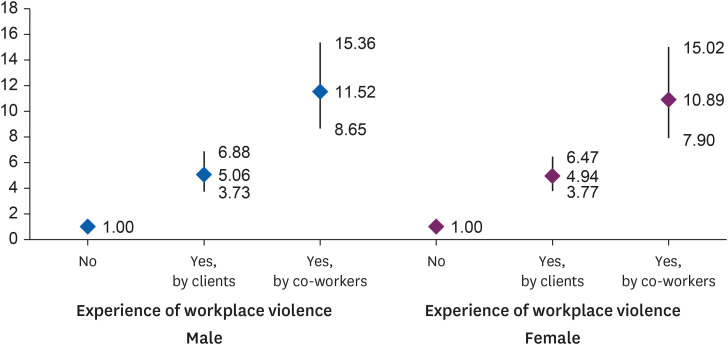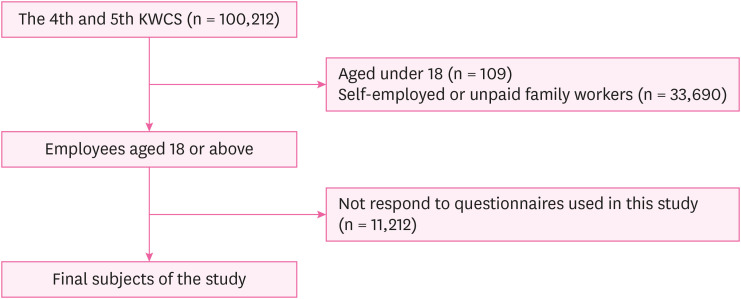Articles
- Page Path
- HOME > Ann Occup Environ Med > Volume 34; 2022 > Article
- Original Article Relationship between workplace violence and work-related depression/anxiety, separating the types of perpetrators: a cross-sectional study using data from the fourth and fifth Korean Working Conditions Surveys (KWCS)
-
Na-Rae Lee
 , Sang-Woo Kim
, Sang-Woo Kim , Jae-Han Joo
, Jae-Han Joo , Jae-Han Lee
, Jae-Han Lee , June-Hee Lee
, June-Hee Lee , Kyung-Jae Lee
, Kyung-Jae Lee
-
Annals of Occupational and Environmental Medicine 2022;34:e13.
DOI: https://doi.org/10.35371/aoem.2022.34.e13
Published online: June 10, 2022
Department of Occupational and Environmental Medicine, Soonchunhyang University Hospital, Seoul, Korea.
- Correspondence: Kyung-Jae Lee. Department of Occupational and Environmental Medicine, Soonchunhyang University Hospital, 59 Daesagwan-ro, Yongsan-gu, Seoul 04401, Korea. leekj@schmc.ac.kr
Copyright © 2022 Korean Society of Occupational & Environmental Medicine
This is an Open Access article distributed under the terms of the Creative Commons Attribution Non-Commercial License (https://creativecommons.org/licenses/by-nc/4.0/) which permits unrestricted non-commercial use, distribution, and reproduction in any medium, provided the original work is properly cited.
Abstract
-
Background Work is an inseparable element of a person’s life, and violence in the workplace has various effects on individual workers and companies. While most studies have focused on specific industries, very few studies have investigated the influence of workplace violence by co-workers. Therefore, this study aimed to evaluate the association between workplace violence and work-related depression/anxiety in various occupations by differentiating the perpetrators of violence as co-workers and clients.
-
Methods This study was conducted based on data from the 4th and 5th Korean Working Conditions Surveys (KWCS). The experience of workplace violence was classified in terms of the perpetrator: workplace violence by co-workers and that by clients. Work-related depression and anxiety were assessed using questions about health problems related to depression and anxiety and whether the problems were related to work. Descriptive statistics, χ2 tests, and multiple logistic regression analyses were performed using the SPSS 26.0.
-
Results After adjusting for sociodemographic characteristics (age, education, income, subjective health status) and occupational characteristics (occupation, weekly working hours, type of employment, size of workplace, and shift work), male workers with experience of workplace violence by co-workers were found to be at a higher risk of work-related depression/anxiety (odds ratio [OR], 11.52; 95% confidence interval [CI], 8.65–15.36). The same was confirmed for female workers (OR, 10.89; 95% CI, 7.90–15.02).
-
Conclusions Employees who experienced workplace violence from co-workers were found to be more vulnerable to work-related depression/anxiety. Continuous contact between the victim and the perpetrator may occur, and the possibility of a secondary assault can frighten the victim. Appropriate prevention and intervention measures that focus on the perpetrators of violence are needed.
BACKGROUND
METHODS
Work-related depression/anxiety
Workplace violence
Sociodemographic characteristics
Occupational characteristics
RESULTS
General characteristics of the study population according to their experience of workplace violence
The proportion of work-related depression/anxiety with respect to the experience of workplace violence, stratified by sex
Multiple logistic regression analysis of work-related depression/anxiety according to workplace violence, stratified by sex
Odds ratios and 95% confidence intervals of work-related depression/anxiety according to the experience of workplace violence, adjusted by sociodemographic characteristics and occupational characteristics.

DISCUSSION
CONCLUSIONS
ACKNOWLEDGEMENTS
-
Funding: This work was supported by the research fund from Soonchunhyang University.
-
Competing interests: The authors declare that they have no competing interests.
-
Author Contributions:
Conceptualization: Lee NR.
Data curation: Lee NR, Kim SW, Joo JH, Lee JH.1
Formal analysis: Lee NR.
Supervision: Lee JH,2 Lee KJ.
Writing - original draft: Lee NR.
Writing - review & editing: Lee NR, Lee JH,2 Lee KJ.
Lee JH,1 Jae-Han Lee; Lee JH,2 June-Hee Lee.
NOTES
SUPPLEMENTARY MATERIALS
Supplementary Table 1
Supplementary Table 2
- 1. Bereau of Labor Statistics. American time use survey–May to December 2019 and 2020 results. Updated 2021]. Accessed January 3, 2022]. https://www.bls.gov/news.release/pdf/atus.pdf .
- 2. International Labor Office. Work-Related Violence and Its Integration Into Existing Surveys. 19th International Conference of Labour Statisticians. Geneva, Switzerland: International Labor Office; 2013.
- 3. di Martino V. Relationship Between Work Stress and Workplace Violence in the Health Sector. Workplace Violence in the Health Sector. Geneva, Switzerland: International Labour Office, International Council of Nurses, World Health Organization; 2003.
- 4. U.S. Department of Labor OSHA. OSHA Fact sheet workplace violence. Updated 2002]. Accessed January 3, 2022]. https://www.osha.gov/sites/default/files/publications/factsheet-workplace-violence.pdf .
- 5. Eurofound. Sixth European Working Conditions Survey – Overview Report (2017 Update). Luxembourg: Publications Office of the European Union; 2017.
- 6. Yoo M, Lee S, Kang MY. Gender and educational level modify the relationship between workplace mistreatment and health problems: a comparison between South Korea and EU countries. J Occup Health 2015;57(5):427–437. 26119208.ArticlePubMedPMCPDF
- 7. Lanctôt N, Guay S. The aftermath of workplace violence among healthcare workers: A systematic literature review of the consequences. Aggress Violent Behav 2014;19(5):492–501.Article
- 8. Magnavita N, Di Stasio E, Capitanelli I, Lops EA, Chirico F, Garbarino S. Sleep problems and workplace violence: a systematic review and meta-analysis. Front Neurosci 2019;13:997. 31632231.ArticlePubMedPMC
- 9. Mento C, Silvestri MC, Bruno A, Muscatello MR, Cedro C, Pandolfo G, et al. Workplace violence against healthcare professionals: a systematic review. Aggress Violent Behav 2020;51:101381.Article
- 10. Kivimäki M, Virtanen M, Vartia M, Elovainio M, Vahtera J, Keltikangas-Järvinen L. Workplace bullying and the risk of cardiovascular disease and depression. Occup Environ Med 2003;60(10):779–783. 14504368.ArticlePubMedPMC
- 11. Xu T, Magnusson Hanson LL, Lange T, Starkopf L, Westerlund H, Madsen IE, et al. Workplace bullying and workplace violence as risk factors for cardiovascular disease: a multi-cohort study. Eur Heart J 2019;40(14):1124–1134. 30452614.ArticlePubMed
- 12. Hoel H, Sparks K, Cooper CL. The Cost of Violence/Stress at Work and the Benefits of a Violence/Stress-Free Working Environment. Geneva, Switzerland: International Labour Organization; 2001.
- 13. Nyberg A, Kecklund G, Hanson LM, Rajaleid K. Workplace violence and health in human service industries: a systematic review of prospective and longitudinal studies. Occup Environ Med 2021;78(2):69–81. 32414952.ArticlePubMedPMC
- 14. Piquero NL, Piquero AR, Craig JM, Clipper SJ. Assessing research on workplace violence, 2000–2012. Aggress Violent Behav 2013;18(3):383–394.Article
- 15. Michie S. Causes and management of stress at work. Occup Environ Med 2002;59(1):67–72. 11836475.ArticlePubMedPMC
- 16. Wheatley D. Stress, anxiety and depression. Stress Med 1997;13(3):173–177.Article
- 17. Kim JH, Lee N, Kim JY, Kim SJ, Okechukwu C, Kim SS. Organizational response to workplace violence, and its association with depressive symptoms: a nationwide survey of 1966 Korean EMS providers. J Occup Health 2019;61(1):101–109. 30698342.ArticlePubMedPMCPDF
- 18. Kim GH, Lee HS, Jung SW, Lee JG, Lee JH, Lee KJ, et al. Emotional labor, workplace violence, and depressive symptoms in female Bank employees: a questionnaire survey using the K-ELS and K-WVS. Ann Occup Environ Med 2018;30(1):17. 29564140.ArticlePubMedPMCPDF
- 19. Gong Y, Han T, Chen W, Dib HH, Yang G, Zhuang R, et al. Prevalence of anxiety and depressive symptoms and related risk factors among physicians in China: a cross-sectional study. PLoS One 2014;9(7):e103242. 25050618.ArticlePubMedPMC
- 20. Yoo T, Ye B, Kim JI, Park S. Relationship of workplace violence and perpetrators on sleep disturbance-data from the 4th Korean working conditions survey. Ann Occup Environ Med 2016;28:59. 27777783.ArticlePubMedPMCPDF
- 21. Geoffrion S, Goncalves J, Marchand A, Boyer R, Marchand A, Corbière M, et al. Post-traumatic reactions and their predictors among workers who experienced serious violent acts: are there sex differences? Ann Work Expo Health 2018;62(4):465–474. 29548023.ArticlePubMedPMC
- 22. Merecz D, Drabek M, Mościcka A. Aggression at the workplace--psychological consequences of abusive encounter with coworkers and clients. Int J Occup Med Environ Health 2009;22(3):243–260. 19819835.ArticlePubMed
- 23. Shi L, Wang L, Jia X, Li Z, Mu H, Liu X, et al. Prevalence and correlates of symptoms of post-traumatic stress disorder among Chinese healthcare workers exposed to physical violence: a cross-sectional study. BMJ Open 2017;7(7):e016810.ArticlePubMedPMC
- 24. Aytaç S, Dursun S. The effect on employees of violence climate in the workplace. Work 2012;41(Suppl 1):3026–3031. 22317180.ArticlePubMed
- 25. Tiller JW. Depression and anxiety. Med J Aust 2013;199:S28–S31. 25370281.ArticlePubMedPDF
- 26. Wittchen HU, Kessler RC, Pfister H, Höfler M, Lieb R. Why do people with anxiety disorders become depressed? A prospective-longitudinal community study. Acta Psychiatr Scand Suppl 2000;102(406):14–23.Article
- 27. Regier DA, Rae DS, Narrow WE, Kaelber CT, Schatzberg AF. Prevalence of anxiety disorders and their comorbidity with mood and addictive disorders. Br J Psychiatry Suppl 1998;173(34):24–28.Article
- 28. Zbozinek TD, Rose RD, Wolitzky-Taylor KB, Sherbourne C, Sullivan G, Stein MB, et al. Diagnostic overlap of generalized anxiety disorder and major depressive disorder in a primary care sample. Depress Anxiety 2012;29(12):1065–1071. 23184657.ArticlePubMedPMC
- 29. Gorman JM. Comorbid depression and anxiety spectrum disorders. Depress Anxiety 1996-1997;4(4):160–168.Article
- 30. Boyer P. Do anxiety and depression have a common pathophysiological mechanism? Acta Psychiatr Scand Suppl 2000;102(406):24–29.Article
- 31. Ruser JW. Examining evidence on whether BLS undercounts workplace injuries and illnesses. Mon Labor Rev 2008;20–32.
- 32. Rosenman KD, Kalush A, Reilly MJ, Gardiner JC, Reeves M, Luo Z. How much work-related injury and illness is missed by the current national surveillance system? J Occup Environ Med 2006;48(4):357–365. 16607189.ArticlePubMed
- 33. World Health Organization. Depression and Other Common Mental Disorders: Global Health Estimates. Geneva, Switzerland: World Health Organization; 2017.
- 34. Renner F, Cuijpers P, Huibers MJ. The effect of psychotherapy for depression on improvements in social functioning: a meta-analysis. Psychol Med 2014;44(14):2913–2926. 24472135.ArticlePubMed
- 35. Lenze EJ, Dew MA, Mazumdar S, Begley AE, Cornes C, Miller MD, et al. Combined pharmacotherapy and psychotherapy as maintenance treatment for late-life depression: effects on social adjustment. Am J Psychiatry 2002;159(3):466–468. 11870013.ArticlePubMed
- 36. Cerel J, Jordan JR, Duberstein PR. The impact of suicide on the family. Crisis 2008;29(1):38–44. 18389644.ArticlePubMed
- 37. Richards J. Management of Workplace Violence Victims. Geneva, Switzerland: Joint Programme on Workplace Violence in the Health Sector; 2003.
- 38. Ministry of Employment and Labor. Workplace harassment judgment, prevention and response manual. Updated 2019]. Accessed January 6, 2022]. https://www.moel.go.kr/policy/policydata/view.do?bbs_seq=20190700773 .
REFERENCES
REFERENCES
Figure & Data
REFERENCES
Citations

- Customer verbal abuse is associated with depressive symptoms among high-workload cosmetics sales workers in South Korea
Ji-Hwan KIM, Bokyoung CHOI, Jaehong YOON, Junghun YOO, Glorian SORENSEN, Seung-Sup KIM
Industrial Health.2025; 63(2): 198. CrossRef - Associations Between Workplace Violence and Work Performance Among Nurses: A Longitudinal Study Based on Affective Events Theory
Yifei Pei, Yiping Xiao, Xuan Zhang, Yan'e Lu, Meng Sun, Ran Lyu, Fenglin Cao
Journal of Clinical Nursing.2025;[Epub] CrossRef - Central Health Problems of Older Adults Working Beyond Pension Age: Applying Network Analysis to Korean Working Conditions Survey
Layoung Kim, Gwang Suk Kim, Min Kyung Park, Jae Jun Lee
Journal of Aging & Social Policy.2025; : 1. CrossRef - Comparison of the Association Between Presenteeism and Absenteeism among Replacement Workers and Paid Workers: Cross-sectional Studies and Machine Learning Techniques
Heejoo Park, Juho Sim, Juyeon Oh, Jongmin Lee, Chorom Lee, Yangwook Kim, Byungyoon Yun, Jin-ha Yoon
Safety and Health at Work.2024; 15(2): 151. CrossRef - Effects of Workplace Violence on Emotional Distress
SoHyun Woo, Heeseung Choi, Soyoun Shin
Journal of Psychosocial Nursing and Mental Health Services.2024; 62(4): 24. CrossRef - Exploring the role of climate for conflict management and high involvement work practices as moderators in the workplace bullying and work-related depression link
Emre Burak Ekmekcioglu, Hamidah Nabawanuka, Yussif Mohammed Alhassan, John Yaw Akparep, Cansu Ergenç
International Journal of Conflict Management.2024; 35(4): 707. CrossRef - Cross-sectional analysis of the association between information and communication technology and mental health among Korean workers
Yeona Shin, Seunghyun Lee, Wanhyung Lee, Pei Boon Ooi
PLOS ONE.2024; 19(11): e0310248. CrossRef - Reciprocal longitudinal associations of supportive workplace relationships with depressive symptoms and self-rated health: A study of Korean women
Seong-Uk Baek, Jin-Ha Yoon, Jong-Uk Won
Social Science & Medicine.2023; 333: 116176. CrossRef - Workplace violence and interpersonal deviance among Pakistani nurses: role of sense of coherence
Ali Waqas, Shahbaz Haider, Riaz Ahmed, Abida Abdul Khaliq, Kareem M. Selem
Current Psychology.2023; 42(4): 3411. CrossRef - Associations between work-related variables and workplace violence among Chinese medical staff: A comparison between physical and verbal violence
Long Sun, Wen Zhang, Aihua Cao
Frontiers in Public Health.2023;[Epub] CrossRef
- Figure
- Related articles
-
- Association between sudden work recall and psychological health issues: a cross-sectional analysis of the 6th Korean Working Conditions Survey
- Association between receiving work communications outside of work hours via telecommunication devices and work-related headaches and eyestrain: a cross-sectional analysis of the 6th Korean Working Conditions Survey
- Association between irregular working hours and work-related musculoskeletal pain: results from the 6th Korean Working Conditions Survey


Fig. 1
Fig. 2
| Variables | Total (n = 55,201) | Experience of workplace violence | ||||
|---|---|---|---|---|---|---|
| No | Yes, by clients | Yes, by co-workers | ||||
| Sex | < 0.001 | |||||
| Male | 27,401 (49.6) | 25,521 (93.1) | 1,209 (4.4) | 671 (2.4) | ||
| Female | 27,800 (50.4) | 25,767 (92.7) | 1,548 (5.6) | 485 (1.7) | ||
| Age | < 0.001 | |||||
| < 30 | 7,703 (14.0) | 6,986 (90.7) | 518 (6.7) | 199 (2.6) | ||
| 30–39 | 13,214 (23.9) | 12,299 (93.1) | 604 (4.6) | 311 (2.4) | ||
| 40–49 | 15,097 (27.3) | 14,070 (93.2) | 733 (4.9) | 294 (1.9) | ||
| 50–59 | 11,875 (21.5) | 11,108 (93.5) | 565 (4.8) | 202 (1.7) | ||
| ≥ 60 | 7,312 (13.2) | 6,825 (93.3) | 337 (4.6) | 150 (2.1) | ||
| Education | < 0.001 | |||||
| ≤ Middle school | 6,738 (12.2) | 6,274 (93.1) | 292 (4.3) | 173 (2.6) | ||
| High school | 20,169 (36.5) | 18,453 (91.5) | 1,302 (6.5) | 414 (2.1) | ||
| ≥ College | 28,294 (51.3) | 26,561 (93.9) | 1,164 (4.1) | 569 (2.0) | ||
| Income | < 0.001 | |||||
| Low | 16,436 (29.8) | 15,145 (92.1) | 970 (5.9) | 321 (2.0) | ||
| Middle | 14,752 (26.7) | 13,585 (92.1) | 804 (5.5) | 363 (2.5) | ||
| High | 24,013 (43.5) | 22,558 (93.9) | 983 (4.1) | 472 (2.0) | ||
| Subjective health status | < 0.001 | |||||
| Good | 53,527 (97.0) | 49,859 (93.1) | 2,617 (4.9) | 1,051 (2.0) | ||
| Bad | 1,674 (3.0) | 1,429 (85.4) | 140 (8.4) | 105 (6.3) | ||
| Occupation | < 0.001 | |||||
| White-collar | 19,375 (35.1) | 18,439 (95.2) | 549 (2.8) | 387 (2.0) | ||
| Blue-collar | 20,217 (36.6) | 18,890 (93.4) | 736 (3.6) | 591 (2.9) | ||
| Pink-collar | 15,609 (28.3) | 13,959 (89.4) | 1,472 (9.4) | 178 (1.1) | ||
| Weekly working hours | < 0.001 | |||||
| < 40 hours | 8,271 (15.0) | 7,736 (93.5) | 407 (4.9) | 128 (1.5) | ||
| 40–51 hours | 37,937 (68.7) | 35,555 (93.7) | 1,604 (4.2) | 778 (2.1) | ||
| ≥ 52 hours | 8,993 (16.3) | 7,997 (88.9) | 746 (8.3) | 250 (2.8) | ||
| Type of employment | < 0.001 | |||||
| Regular | 41,819 (75.8) | 39,043 (93.4) | 1,961 (4.7) | 815 (1.9) | ||
| Temporary | 13,382 (24.2) | 12,245 (91.5) | 796 (5.9) | 341 (2.5) | ||
| Size of workplace | < 0.001 | |||||
| Small (1–9 workers) | 23,442 (42.5) | 21,773 (92.9) | 1,295 (5.5) | 374 (1.6) | ||
| Medium (10–249 workers) | 26,888 (48.7) | 24,975 (92.9) | 1,262 (4.7) | 651 (2.4) | ||
| Large (≥ 250 workers) | 4,871 (8.8) | 4,540 (93.2) | 200 (4.1) | 131 (2.7) | ||
| Shift work | < 0.001 | |||||
| Yes | 6,232 (11.3) | 5,368 (86.1) | 711 (11.4) | 153 (2.5) | ||
| No | 48,969 (88.7) | 45,920 (93.8) | 2,046 (4.2) | 1,003 (2.0) | ||
| Experience of workplace violence | Male | Female | ||||
|---|---|---|---|---|---|---|
| Work-related depression/anxiety | Work-related depression/anxiety | |||||
| No | Yes | No | Yes | |||
| No | 25,272 (99.0) | 249 (1.0) | < 0.001 | 25,515 (99.0) | 252 (1.0) | < 0.001 |
| Yes, by clients | 1,147 (94.9) | 62 (5.1) | 1,469 (94.9) | 79 (5.1) | ||
| Yes, by co-workers | 598 (89.1) | 73 (10.9) | 430 (88.7) | 55 (11.3) | ||
| Variables | Experience of workplace violence | Male | Female | ||
|---|---|---|---|---|---|
| OR | 95% CI | OR | 95% CI | ||
| Crude | No | Reference | Reference | ||
| Yes, by clients | 5.49 | 4.13–7.29 | 5.45 | 4.21–7.05 | |
| Yes, by co-workers | 12.39 | 9.43–16.28 | 12.95 | 9.53–17.60 | |
| Model Ia | No | Reference | Reference | ||
| Yes, by clients | 5.65 | 4.23–7.56 | 5.15 | 3.96–6.69 | |
| Yes, by co-workers | 11.77 | 8.87–15.62 | 11.29 | 8.22–15.49 | |
| Model IIb | No | Reference | Reference | ||
| Yes, by clients | 5.06 | 3.73–6.88 | 4.94 | 3.77–6.47 | |
| Yes, by co-workers | 11.52 | 8.65–15.36 | 10.89 | 7.90–15.02 | |
Values are presented as number (%).
aCalculated by χ2 test.
Values are presented as number (%).
aCalculated by χ2 test.
OR: odds ratio; CI: confidence interval.
aAdjusted by sociodemographic characteristics (age, education, income, subjective health status); bAdjusted by sociodemographic characteristics and occupational characteristics (occupation, weekly working hours, type of employment, size of workplace, shift work).
 KSOEM
KSOEM


 Cite
Cite

